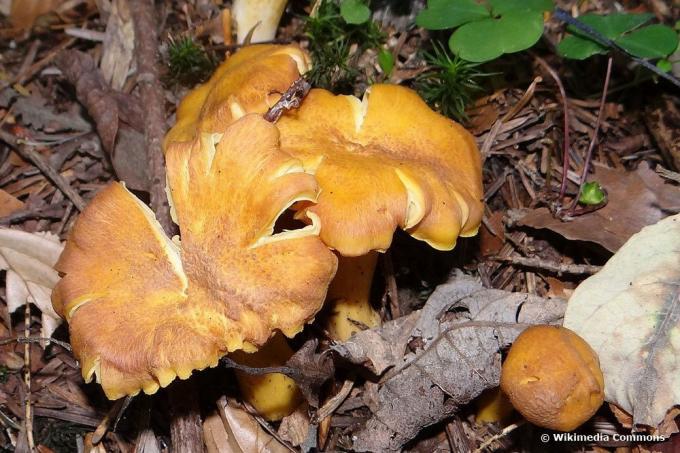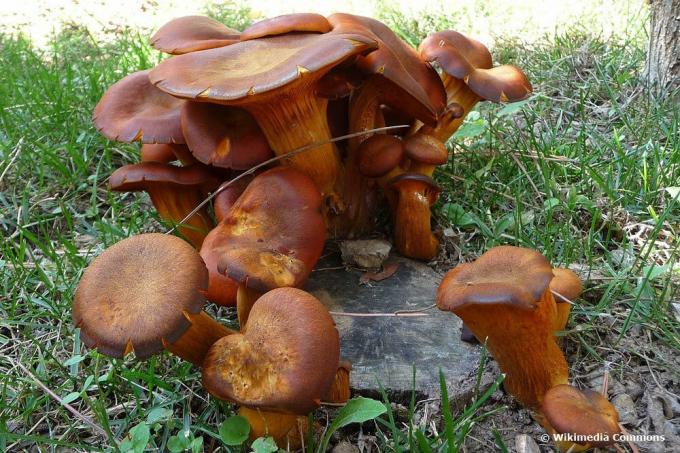
table of contents
- Three common types in Germany
- Recognizing chanterelles: 5 rules
- cap
- Handle and ledge
- meat
- odor
- taste
- Insidious doppelgangers
Collecting and recognizing chanterelles has to be learned. Insidious doppelgangers punish a mistake with bad stomach complaints. These 5 rules with picture ensure safety and carefree mushroom enjoyment. This is how you determine an original chanterelle with expertise.
Three common types in Germany
The genus of chanterelles (Cantharellus) populates the deciduous and mixed forests of Europe with 14 species and varieties. The following 3 types are common in German forests and are very popular among mushroom pickers as delicate edible mushrooms:

- Chanterelle, Chanterelle (Cantharellus cibarius)
- Velvety chanterelle, velvet chanterelle (Cantharellus friesii)
- Amethyst chanterelle, violet-scaly chanterelle (Cantharellus amethysteus)
To call these three chanterelles profane as edible does not do justice to the unique aroma. Their high esteem as a delicacy results not least from the fact that they are authentic natural treasures that persistently refuse to be commercially grown. The time window for the chanterelles
season is only open a few months of the year from summer to early autumn.Recognizing chanterelles: 5 rules
So that you do not miss any of these premium mushrooms while collecting, the following five basic rules explicitly draw attention to the subtle differences between the delicious protagonists.
cap
The most distinctive feature of a chanterelle is its hat. Size, shape and color act as reliable indicators for a stable identification. The focus is on the following attributes:
Chanterelle (Cantharellus cibarius)

- Hat diameter: 2-8 cm (rarely up to 15 cm)
- Color: yolk yellow to lemon yellow, hat diameter: 1-5 cm
Velvety Chanterelle (Cantharellus friesii)

- Color: orange to orange-yellow
- Special features: velvety surface, orange-pink to yellowish hat underside, later fading
Amethyst Chanterelle (Cantharellus amethysteus)
- Hat diameter: 2-8 cm (rarely up to 20 cm)
- Color: yellow with purple flakes
- Special feature: purple spots of color on the edge of the hat

In terms of shape, there are no differences between the three types of chanterelle. At the beginning the hat has a hemispherical to arched shape, which gradually turns inside out to a funnel-like appearance. Characteristic is an irregularly wavy hat rim, which sometimes rolls up slightly in older specimens.
Handle and ledge
Chanterelles wear their memorable hat on a full-fleshed, hat-colored stem. This aspect does not make a decisive difference to numerous other types of mushroom. On the other hand, if you take a look under the hat, you will find an essential distinguishing feature in the form of strips. All chanterelles thrive with sloping ridges. These are firmly attached to the pulp.
Chanterelle (Cantharellus cibarius)

- Handle height: 3-6 cm (rarely up to 8 cm)
- Last: hat-colored, narrow, forked and connected to one another, gradually tapering off at the end of the handle
Velvety Chanterelle (Cantharellus friesii)

- Handle height: 2-4 cm (rarely up to 8 cm)
- Last: whitish to light yellow, thick, forked with cross connections, wrinkled
Amethyst Chanterelle (Cantharellus amethysteus)

- Handle height: 1-3 cm (rarely up to 5 cm)
- Last: yellowish, forked several times, sloping down a long way
Mushroom science differentiates between strips and lamellas. In this context, all chanterelles are categorized as groin mushrooms. Beginners cannot always tell the difference between strips and slats. In this case, a simple trick can shed some light. Run your finger over the region in question under the hat. In contrast to firmly overgrown strips, the lamellae can be moved or detached from the pulp with light finger pressure.
Tip: Knowledgeable mushroom pickers leave a young chanterelle standing when it is peeking out of the forest floor. Collecting tiny young mushrooms is not only unproductive and frowned upon as greed. Furthermore, this "baby murder" harbors the great danger of mistaking the mushroom youth for a poisonous doppelganger.
meat
To apply the third rule, please have a sharp knife on hand. Cut the mushroom lengthways. Chanterelles can be recognized by their firm, pale yellow flesh. In fully grown mushrooms, the crunchy pulp is characterized by a yellowish edge.
odor

Every original chanterelle is a feast for the senses. If you have discovered a golden yellow treasure in the forest, you are welcome to sniff it. If you perceive a fruity-fresh scent with a light apricot note, hold a real chanterelle in your hands. The velvet chanterelle reveals a pleasant scent of mirabelle plums. Connoisseurs of the matter swear that a purple-scaly chanterelle smells a little more spicy than its fellow species.
taste
The fifth rule for reliable identification of chanterelles requires a taste. A real chanterelle should live up to its name with a sharp, spicy taste of pepper. Gourmets attest the velvet chanterelle and amethyst chanterelle a slightly milder aroma.
Note: Please note that these rules for recognizing chanterelles are primarily intended as a guide. By submitting your mushroom yield to a certified expert for assessment, you are on the safe side. You will find what you are looking for at the German Society for Mycology e. V. On the homepage you can find the contact details for a mushroom expert using a search function by postcode.
Insidious doppelgangers
Two mushrooms romp about in deciduous and mixed forests, which in the truest sense of the word are “not worth a chanterelle”. Confusing these two doppelgangers with real chanterelles is punished with excruciating gastrointestinal complaints and even serious organ damage. To save you from making a mistake, we will highlight the five rules for recognizing chanterelles from the perspective of their treacherous counterparts below:
False chanterelle, fork leaved (Hygrophoropsis aurantiaca) - poisonous

- Hat: 2-12 cm in diameter, bright orange
- Handle and strips: 3-7 cm high, 3-8 cm wide with removable slats
- Flesh: whitish, tough, pliable to soft
- Odor: neutral or herbaceous to sour
- Taste: fluffy-mild to slightly bitter
A small sample means no danger for healthy adults. Consumption of false chanterelles only causes nausea, stomach cramps and vomiting in large quantities.
Olive funnel, dark olive mushroom (Omphalotus olearius) - poisonous
- Hat: 3-11 cm, strong orange to rust brown, thin-fleshed,
- Handle and strips: 5-15 cm, golden yellow, removable slats that glow in the dark
- Flesh: yellowish to orange, tough, fibrous
- Odor: unpleasant like putrid softwood
- Taste (optional): repulsive-mild

We strongly advise against tasting it. In order not to confuse the poisonous doppelganger with real chanterelles, the test should be limited to visual characteristics and smell. Dark olive mushrooms are very poisonous. Consumption in small amounts can cause considerable symptoms of intoxication and even liver damage.
With the help of these hints, did you find out about an inedible chanterelle doppelganger? Then please don't destroy the fungal impostor. All mushrooms make an invaluable contribution to the ecological balance of nature. The poisonous mushroom that hits people hard on the stomach is often a valuable source of food for wild animals.



